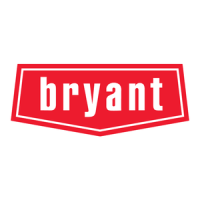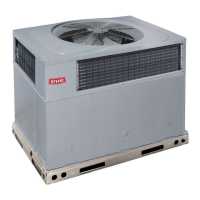
Do you have a question about the Bryant 602A Series and is the answer not in the manual?
Summarizes warnings, safety alerts, and personal protective equipment requirements.
Describes the heat pump's purpose and configuration for outdoor installation.
Covers checking model number, serial number, and shipment condition upon arrival.
Discusses roof curb, slab, and ground mounting options for unit installation.
Details required space for airflow and service access around the unit.
Outlines safe lifting and moving methods, emphasizing trained personnel.
Covers compliance with NFPA, ASHRAE standards for duct system design.
Includes using flexible connectors and fireproof materials for vibration isolation.
Details the steps to change the unit's discharge configuration from horizontal to downflow.
Details condensate trap installation and proper slope for drainage.
Covers grounding, NEC, CSA codes, and proper wiring practices.
Discusses disconnect switches, circuit breaker sizing, and wiring.
Explains conduit use and wire entry for high-voltage power leads.
Describes connecting the ground lead to the chassis using the ground lug.
Explains routing thermostat wires with drip loops and connecting to unit leads.
Details rewiring the transformer primary for 208V operation.
Covers checking for shipping damages, refrigerant leaks, and wiring connections.
Procedure for locating, repairing leaks, and reclaiming refrigerant.
Covers checking compressor and control operation for cooling and heating modes.
Explains checking system charge levels using charts and pressure gauges.
Refers to nameplate and data tables for the correct refrigerant quantity.
Steps for charging an empty system, including evacuation and weighing refrigerant.
Discusses CFM needs, motor speed changes, and airflow adjustment procedures.
Lists monthly and seasonal inspection and cleaning tasks for the unit.
Instructions for filter inspection, cleaning, or replacement.
Covers cleaning procedures and notes on motor lubrication.
Describes procedures for cleaning condenser/evaporator coils and the drain pan.
Covers checking fan blades for damage and fan replacement procedures.
Checking electrical connections for tightness and component operation.
Checking refrigerant tubing connections for oil accumulation indicating leaks.
When to check airflow and what to inspect for proper performance.
Describes the location of fixed orifice refrigerant metering devices.
Describes the purpose and placement of liquid line strainers.
Explains the location and identification of high flow valves.
Explains its function in controlling indoor blower operation after thermostat satisfaction.
Describes its pressure activation range and location on the outdoor liquid line.
Describes the mounting location on the outdoor coil liquid header.
Explains its role in signaling heat pump defrost cycles based on temperature.
Refers the user to Table 11 for detailed troubleshooting information.
General instruction to use the Start-Up Checklist for proper initial operation.
Diagnoses common causes for compressor and outdoor fan not starting.
Addresses issues like short cycling, continuous operation, and noise.
Covers problems associated with excessive head pressure and low suction pressure.
Diagnoses low suction pressure and intermittent indoor fan motor operation.
Collecting essential job and unit identification details before start-up.
Verifying unit condition, connections, filter, level, and fan placement.
Recording initial voltage, current, temperature, and pressure readings.












